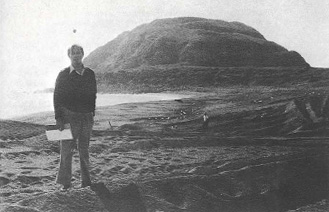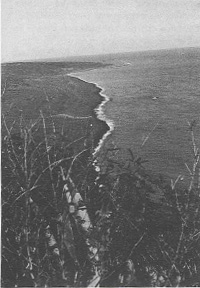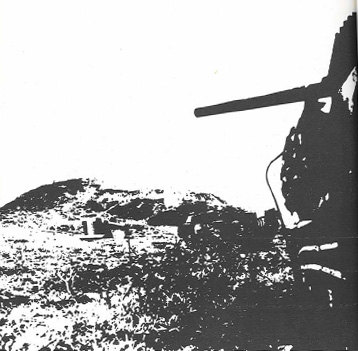Goodbye, Darkness (49 page)

But their men kept fighting. Instead of holing up and awaiting destruction, they donned Marine uniforms stripped from the American dead and crept out of their caves at night with rifles, swords, grenades, and knee mortars, so called because the tube was braced on the knee. (There were also wild stories about “ball mortars,” which, fired from the crotch, emasculated the mortarmen. The myth is worth noting because it illustrates our conviction that the Japs would sacrifice anything for their emperor.) Iwo was declared secure on March 16 and the operation officially completed ten days later, but heavy ground fighting continued, with the Marines taking another 3,885 casualties before GIs arrived to garrison the island. Even then, the soldiers had to spend another two months mopping up. It was depressing; the closer we came to Japan, the more tenacious the defenders were. No one wanted to talk about, or even think about, what would happen when we invaded their home islands.
James Forrestal, secretary of the navy, said of Iwo: “I can never again see a United States Marine without feeling a reverence.” The price of the little island had been 25,851 Marines, including 19 battalion commanders. Battle casualties in the rifle regiments had come to 60 percent in the Third Marine Division and 75 percent in the Fourth and Fifth divisions. But they had done the job. On March 4 the first crippled B-29 had wobbled into a crash landing on Airfield No. 1. Three weeks later, with the battle still raging in the northern pockets of the isle, Superfortresses began regular runs from Iwo's three fields to Tokyo. Before V-J Day, 2,251 B-29s, carrying 24,761 crewmen, had made successful landings on Iwo's airstrips. One Air Corps pilot who made three of them told a
Time
reporter: “Whenever I land on this island, I thank God and the men who fought for it.”
Of the war's last two great battlefields, Iwo Jima and Okinawa, Iwo is far more difficult to reach today. Yokota, a remote American air base on Honshu, Japan, sends one Coast Guard plane there each week with provisions, but a civilian cannot board it without clearance from Washington. The aircraft is a Lockheed C-130, normally used as a cargo plane; there are no seats and no heat. It is uncomfortable and therefore suitable for your miserable mission. When you land on the seventy-five-hundred-foot jet runway and climb down the ramp, your first full breath is sulfurous. You can almost see the air you are inhaling, and for the first few minutes it is nauseating. Then you board a truck sent to pick up the provisions. Geodetic faults buckle and twist the roads, so that driving is a jarring experience, inducing motion sickness. And then there are the winds. This is a stormy climate. The shape of Iwo is in fact altered slightly by each typhoon. (Recently Suribachi's shape was also transformed by demolitions experts taking safety measures against further volcanic eruptions.)
Your first thought, upon reaching the island, is how to flee from it. Timid visitors may reach a pitch bordering on panic; for some inexplicable reason, newcomers are pursued by an irrational fear that the isle is about to sink into the sea. Actually it has risen thirty-four feet since the war, but it seems too small to survive. The whole of it, including the landing beach, can be seen from the top of Suribachi. Today Iwo is largely green, covered with a low, almost indestructible form of plant life. During the American occupation there was talk of using it as a missile base, but it came to nothing. Only flocks of wild goats share the island with the men stationed there. In 1968, when the United States formally returned it to the Japanese, Tokyo's diplomats expressed gratitude, but they couldn't have been serious.
One has the instinctive feeling that the raging past is very much present here. Japs were still emerging from the ground years after the war, and the number listed as missing is staggering. When intact corpses are found, the Japanese Graves Registration Commission sends its teams with tanks of fuel; the bones are burned, and if the body can be identified, the family is notified. There seems to be no limit to the foreign objects below Iwo's black silt surface. Thus far, 560 major pillboxes have been uncovered. Relatives of slain Japanese who are successful in wangling space on the weekly flight first climb on Suribachi, to view the island, the beach, and the surf. Then they visit the memorials. The chief American monument is a bas-relief of the Suribachi flag raising, and it is sad to note that it is marred by many graffiti. The names are both American and Japanese — A. L. Warren and R. H. Nakamura, for example — suggesting a diaspora of vandals, but the disfigurement is depressing all the same. Even Kilroy had the good taste to leave this place alone.
My flight back to Japan will leave in an hour or so, and I am standing outside a Quonset-hut barracks, talking to Lieutenant Julilo Oshikawa, one of the officers commanding the Japanese troops stationed here.
Japanese
troops? On
Iwo Jima?
Yes; and eventually this will be a base for more of Hirohito's soldiers than those who fought here under Kuribayashi. It is startling, but there is a benign explanation. Since 1945 Nippon's civilians have been so hostile toward soldiers wearing their country's uniform that life in the home islands has become unendurable for their Japanese Self-Defense Force. So the government cast about for another depot. Through a bureaucratic freak, Iwo, which could not be accommodated elsewhere in the country's political system, was incorporated into the Tokyo prefecture. When you are on Iwo you are legally within Tokyo's city limits, 660 miles away. Therefore officials in the capital can determine your legal status and clear away batches of paperwork which antimilitarists could exploit. Putting Nipponese soldiers here was a clever solution to a vexing problem, though some Americans may regard it as almost sacrilegious.

The author on the beach at Iwo Jima, with Mount Suribachi in the background

The view of the landing beach from Mount Suribachi
Oshikawa, like his men, is wearing a red baseball cap with yellow felt
kanji
characters designating his rank and unit — a deliberately unmilitaristic hat — and the last thing he wants to discuss is World War II. Therefore I ask him how his men and the Coast Guard meteorologists get along. Pretty well, he says; they jog together, swap movies and girlie magazines, join in resurfacing the airstrip's tarmac when it becomes riddled by sulfur vents from below, and, until the recent completion of a quarter-mile-high radio tower to beam low-frequency weather and navigational messages to ships, gathered together to gawk at the workmen up there. The servicemen from the two nations have a baseball league, sprint against one another, and play tennis in one of the larger bunkers.
Nevertheless there is tension. The Nipponese are bound to resent the fact that every American has an air-conditioned room and, in most cases, his own stereo. On the other hand, the Japanese have access to an unlimited supply of sake, a drink of great authority, while the coastguardsmen are only issued beer. It has always been that way for U.S. troops, and it is stupid. Solace,
any
solace, seems the least that can be done for men marooned here. Yet they don't think theirs a hard lot. They like to jog. They like to roam around alone. They all feel attached to Iwo. It is, they say, so very peaceful. And they mean it; they are too young to remember Iwo's fiery hour in history. Men of my generation, of course, take an altogether different view. To us this battle was the latest in a series which began at Pearl Harbor and became worse and worse. Morison quotes a wounded Marine on Iwo: “I hope to God that we don't have to go on any more of these screwy islands.” Morison then apostrophizes: “Only one more, Marine — the even screwier Okinawa — and the war would be almost over.”

…Then I'll Rise
and Fight with You Again
I
t is time, odysseus said, that i told you of the di
-sastrous voyage Zeus gave me. On Saturday, March 24, 1945, with heavy fighting continuing on Iwo and in the Philippines — and GIs pouring across the Rhine — I was hopping around on the distant island of Mog Mog, trying to dodge American baseball bats aimed at my skull. Is this clear? Am I going too fast for you? Well,
nil desperandum;
the facts are quickly told. Mog Mog is the chief island of Ulithi Atoll in the western Carolines, where 1,457 Allied vessels had assembled for the invasion of Okinawa. Each of the 182,112 U.S. fighting men heading into the battle was to be allowed two hours ashore and all the beer he could drink while PA systems belted out songs popular at home. It was a thoughtful gesture. Unfortunately, the picnic wasn't left at that. Some recreational officer thought red-blooded American boys deserved another outlet. It was his idea to issue us sports equipment, so we could burn up all that energy accumulated during the long voyage here. It didn't work quite as expected. He had no notion of what it meant to be psyched up for combat. We quickly got loaded and called, like Cynara's lover, for madder music and stronger wine. When none was forthcoming, we destroyed most of the sports gear, and the hard-chargers among us began hitting people over the head with Louisville Sluggers. The officer was furious, but his threats were as futile as a clock in an empty house. What could he do? Deprive us of the privilege of getting shot at? It was reminiscent of the notorious “Battle of Brisbane,” earlier in the war, when a file of Australian soldiers leaving their country passed a file of arriving GIs, coming in the other direction. Imprudent GIs mocked the Diggers, promising to lay every Aussie woman, married or not. Shots were exchanged — some men were actually killed — and then the sad affair was quickly hushed up. That sort of thing happens in war, but civilians on the home front cannot be expected to understand it.
Officers and senior NCOs had been briefed earlier on our objective, and once we weighed anchor and left Ulithi on the way to battle, I put my men, as we said then, in the picture. We formed a semicircle on the fantail of our APA, the
George C. Clymer,
and I unrolled a map of the target isle. Okinawa, in the Ryukyu Archipelago, is a big island, sixty miles long and, on the average, eight miles wide, with a fringing reef which would have been dismaying a year earlier but was no problem for our fleets of new amphtracs. The island, lying exactly midway between Formosa and Japan, would be an ideal staging area for our invasion of Dai Nippon. In the north it is rugged and thickly forested; in the south it is rolling and farmed; the Ichikawa Isthmus separates the two. One way of visualizing Okinawa is to compare it to Walt Disney's dog Pluto. The northern two-thirds, the head and long neck, is largely barren; Motobu Peninsula, Pluto's uplifted ear, is mountainous and about the size of Saipan. In the south the small harbor of Naha, the isle's capital, is just forward of the tail. The southern side of that harbor, which would acquire special meaning for me, is Oroku Peninsula. Various other bays, isthmuses, capes, and promontories form the dog's short forelegs and hind feet. Off Motobu, looking like a bee, is the tiny isle of Ie Shima.
General Buckner, our overall U.S. commander, planned to land four divisions on L-day, or Love-Day: Easter Sunday, April 1, 1945. That would leave him with three more divisions for the follow-up and another in reserve. The first waves would hit the Hagushi beaches, just south of the island's midriff. Our immediate objective was the seizure of Yontan and Kadena airfields. The lineup, right to left, would be two army divisions, the Ninety-sixth and the Seventh, then the First and Sixth Marine divisions. Once the airstrips were in our hands, the GIs of the Ninety-sixth and Seventh would wheel south, while the two Marine divisions wheeled northward. The most ambitious goals, or so it then seemed, had been assigned to the Sixth, my division — an amalgam of smaller units, most of which had fought on Guadalcanal, New Georgia, Bougainville, Saipan, and Guam — because the assumption then was that the enemy was entrenched in the north. Aboard ship, sergeants were told to pass along the usual instructions: watch out for snipers, don't shout names (a Jap would shout the same name again a minute later and drill the poor jerk who stuck his head up), maintain fire discipline when the enemy screams to draw fire and thus spot automatic weapons, and if you face a banzai charge, stay loose: don't fire till you see their buckteeth. There was the usual crap about malaria, dengue, filariasis, typhus, leprosy, dysentery, and jungle rot, and what were described as the world's two most deadly snakes, the habu and the kufau. We were issued elaborately printed scrip, as though we would have anything to spend it on. Noncoms were also assembled for a weather briefing. The annual rainfall, we were told, was 120 inches. I'm not sure I wrote that down. I tried to check later, but those pages in my diary were blurred beyond recognition by countless cloudbursts. I can't tell you how much rain there actually was, but 120 inches wasn't even close.
